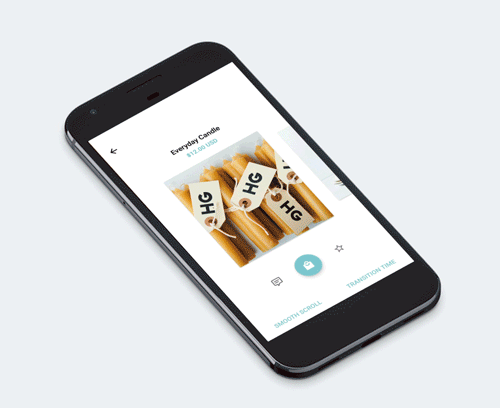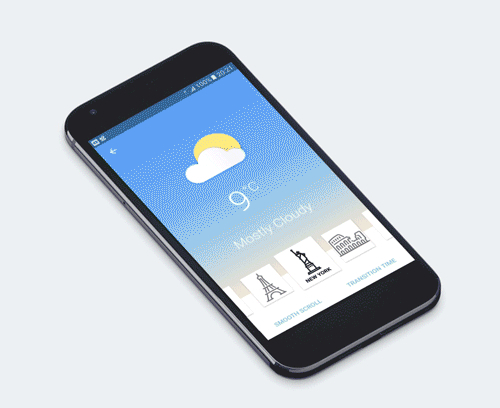DiscreteScrollView library is a RecyclerView-based implementation of a scrollable list, where current item is centered and can be changed using swipes. It is similar to a ViewPager, but you can quickly and painlessly create layout, where views adjacent to the currently selected view are partially or fully visible on the screen.
DiscreteScrollView library Demo


Gradle
Add this into your dependencies block.
compile 'com.yarolegovich:discrete-scrollview:1.1.1'
The library uses a custom LayoutManager to adjust items’ positions on the screen and handle scroll, however it is not exposed to the client code. All public API is accessible through DiscreteScrollView class, which is a simple descendant of RecyclerView.
If you have ever used RecyclerView – you already know how to use this library. One thing to note – you should NOT set LayoutManager.
Usage:
- Add DiscreteScrollView to your layout either using xml or code.
- Create your implementation of RecyclerView.Adapter. Refer to the sample for an example, if you don’t know how to do it.
- Set the adapter.
- You are done!
<com.yarolegovich.discretescrollview.DiscreteScrollView android:id="@+id/picker" android:layout_width="match_parent" android:layout_height="wrap_content" />
DiscreteScrollView scrollView = findViewById(R.id.picker); scrollView.setAdapter(new YourAdapterImplementation());
API
Related to the current item:
scrollView.getCurrentItem(); //returns adapter position of the currently selected item or -1 if adapter is empty. scrollView.scrollToPosition(int position); //position becomes selected scrollView.smoothScrollToPosition(int position); //position becomes selected with animated scroll scrollView.setItemTransitionTimeMillis(int millis); //determines how much time it takes to change the item on fling, settle or smoothScroll
Transformations
One useful feature of ViewPager is page transformations. It allows you, for example, to create carousel effect. DiscreteScrollView also supports page transformations.
scrollView.setItemTransformer(transformer);
public interface DiscreteScrollItemTransformer {
/**
* In this method you apply any transform you can imagine (perfomance is not guaranteed).
* @param position is a value inside the interval [-1f..1f]. In idle state:
* |view1| |currentlySelectedView| |view2|
* -view1 and everything to the left is on position -1;
* -currentlySelectedView is on position 0;
* -view2 and everything to the right is on position 1.
*/
void transformItem(View item, float position);
}
Because scale transformation is the most common, I included a helper class – ScaleTransformer, here is how to use it:
cityPicker.setItemTransformer(new ScaleTransformer.Builder() .setMaxScale(1.05f) .setMinScale(0.8f) .setPivotX(Pivot.X.CENTER) // CENTER is a default one .setPivotY(Pivot.Y.BOTTOM) // CENTER is a default one .build());
You may see how it works on GIFs.
Callbacks
- Scroll state changes:
scrollView.setScrollStateChangeListener(listener);
public interface ScrollStateChangeListener<T extends ViewHolder> {
void onScrollStart(T currentItemHolder, int adapterPosition); //called when scroll is started, including programatically initiated scroll
void onScrollEnd(T currentItemHolder, int adapterPosition); //called when scroll ends
/**
* Called when scroll is in progress.
* @param scrollPosition is a value inside the interval [-1f..1f], it corresponds to the position of currentlySelectedView.
* In idle state:
* |view1| |currentlySelectedView| |view2|
* -view1 is on position -1;
* -currentlySelectedView is on position 0;
* -view2 is on position 1.
*/
void onScroll(float scrollPosition);
}
Current selection changes:
scrollView.setCurrentItemChangeListener(listener);
public interface CurrentItemChangeListener<T extends ViewHolder> {
/**
* Called when new item is selected. It is similar to the onScrollEnd of ScrollStateChangeListener, except that it is
* also called when currently selected item appears on the screen for the first time.
*/
void onCurrentItemChanged(T viewHolder, int adapterPosition);
}
Hope you like it please comment your thoughts below.
Share your thoughts